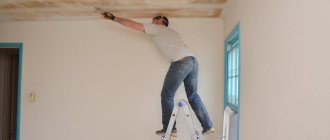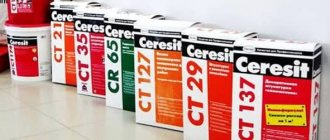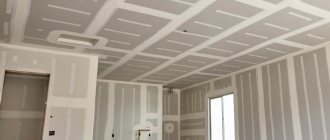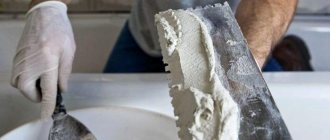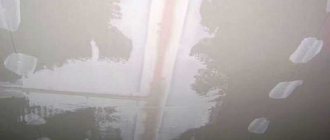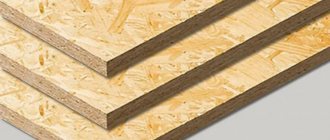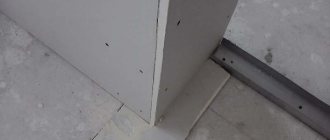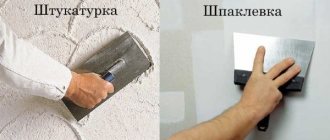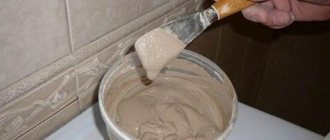Once upon a time, carrying out major renovations in a private house or apartment required a lot of time: saving the required amount, selecting high-quality materials, hiring professional workers. Today, everyone can cope with this task on their own. Practical sheets of plasterboard are best suited for repairs and insulation of premises. Various interiors, expressiveness of rooms - your imagination is limitless. The easiest way to make partitions is from gypsum plasterboard. But, unfortunately, after installation, the sheets of drywall will not create a pleasant atmosphere in your apartment - existing chips, cracks, joints, and protruding screw heads will spoil the overall picture. But there is a way out - putty. A high-quality putty will solve all the problems that arise. The question arises - how to putty drywall ?
Why putty drywall?
Nobody wants to work extra hard, waste precious time on unnecessary work, so we often wonder - is it possible to do without finishing putty, because it is much easier to putty only with rough putty? Yes, in some cases it is possible, but not in all.
Every time after working with drywall, we have to seal the joints, hide the screw caps, and smooth out any unevenness that arose during installation. Also, long-term storage of gypsum boards or improper transportation can also make their own adjustments.
, which is one of the flagships of our market for the production of drywall, makes it possible to avoid puttying gypsum board sheets when using them under wallpaper or tiles, not counting only the corners, joints and the screw heads themselves.
They achieved this goal with the help of a special primer - water-dispersion paint diluted with water. This primer on the surface of the sheet being processed turns into a thin film layer that combines perfectly with any type of adhesive, and also protects the drywall from damage if the wallpaper breaks.
Therefore, the question of how to putty drywall is irrelevant if you choose.
Why do you need putty?
The ability to understand the types of putty for drywall will be useful not only to professionals and repairmen. Knowing about the types of putty mixtures, you will not have to turn to professionals for help, and will be able to carry out finishing repairs yourself.
Perhaps you are just planning a renovation and don’t yet know whether you will need putty. If you are installing a gypsum board wall, you will need to putty it in any case, at least once. There are often cases when it is necessary to apply two or three layers of putty. So in any repair using plasterboard sheets you will have to use putty.
To carry out puttying work you need putty. What is she like? This is a special fast-hardening material. It is intended, as a rule, to level the wall. And also putty is simply necessary in order to carry out the final finishing of the wall with decorative materials. Therefore, putty is a necessary element of finishing a plasterboard wall, which in no case can be excluded.
Using a primer for gypsum boards
There are a number of significant advantages to drywall primer. Firstly, it helps adhesion of adjacent materials, which greatly reduces the occurrence of bubbles and peeling of wallpaper or tiles. Secondly, it is distributed evenly over the entire surface, which helps reduce material consumption.
Primer is always used when finishing rooms, especially when working with drywall, because with its help we improve adhesion with putty and reduce glue consumption when gluing wallpaper. In addition, a primer is also used after the starting putty, so that the finishing layer will stick better, otherwise you may encounter some problems, such as rolling or falling off.
It is best to choose primers depending on the type and stage of work. It is better to use putties that have deep penetration properties.
Types of putties by purpose
The purpose of the putty depends on the composition and permissible operating conditions. The main task of putty work is to create a flat, even surface for painting, wallpaper or other finishing. Putties are divided into three groups:
- starting;
- finishing;
- universal.
Let's look at each type in more detail.
According to their purpose, putties are divided into three main groups
Leveling or starting putty
Usually this is a gypsum mixture in its pure form or with additives to improve plasticity during application. A more modern option is a polymer composition reinforced with fibers, which enhance the strength of the leveling layer of putty and can be painted with pigment. Using leveling putty, rough unevenness is eliminated, the edges of drywall are brought to the required plane, cracks are filled, and joints and screws are hidden. With this putty, masking tapes and nets are used, which are glued to problem areas, joint lines and corners to prevent cracks from forming.
Leveling putty is used to eliminate uneven surfaces and seal seams
Typically, the starting layer has good adhesion and a short solution life.
It is used for rough straightening and is applied in a thin layer over the entire surface of the drywall to create a base for the finish with the same adhesion properties and porosity. It is important to treat the walls and corners so that the final layer is the same thickness at any point in the putty area.
Finishing putty
The last layer of finishing before decoration should be even and smooth. Finishing putty for drywall has these properties. The composition is varied - manufacturers are constantly striving to improve properties and develop new additives. Usually has a white color, is plastic and easily forms an even, smooth plane, and takes a long time to dry. Can be smoothed with fine-grained sandpaper after drying.
Finishing putty is designed to eliminate minor surface defects
Universal putty
This composition is suitable for any type of work. In terms of characteristics, this is the average between the starting and finishing options. Often chosen to avoid preparing drywall in two stages.
It is recommended if the final layer of putty is no more than 3 mm. Then there is no need to use the starting putty, after which you will have to finish the walls.
Universal putty can be used at any stage of construction work
Step-by-step instructions for performing the work
When you have finished installing plasterboard sheets , you will have to further finish them. If you plan to paint, puttying the drywall should be done in at least two stages.
The technology for puttingtying drywall is as follows:
- Be sure to apply a primer with deep penetration properties to the drywall.
- We seal the holes left by the screws.
- We putty the joints.
- We putty internal and external corners.
- Apply primer for gypsum boards.
- Finish the surface with starting putty.
- We sand the rough edges.
- Apply primer to drywall.
- Puttying with finishing composition.
- We cover the walls with primer for final work.
And now we’ll find out what kind of putty to putty on drywall. Both polymer and gypsum are used. Polymer putties are used for final finishing, as they help level the surface. Gypsum, on the other hand, can be both starting and finishing, depending on the size of the grains.
Putty for drywall comes in different types - ready-to-use, or dry, requiring dilution with water. Of course, it is better to use the first one, so you are guaranteed to protect yourself from lumps that can arise if the dosage is not correct, but it is also much more expensive.
Puttying plasterboard walls
For those who like to do repairs themselves, do-it-yourself drywall putty, its step-by-step instructions, must be strictly followed. Otherwise, the apartment will look like a communal apartment of the last century, as a finishing touch. You need to start with the correct arrangement of sheets.
The plasterboard sheets are all attached with their faces facing into the room.
Preparing gypsum boards for puttying
After completing the installation of gypsum boards, careful preparation of drywall for putty is necessary.
- The edges of the sheets have rounded chamfers for filling the joints with the compound. When cutting, the sheet is cut evenly. You should go over all the cut ends and remove the corners. The most convenient way to do this is with a construction knife.
- The screws should be recessed into the sheet by approximately 1 mm. Any protruding caps should be tightened.
- Check that the gypsum board does not sag. In places where the drywall “plays”, install additional fasteners, eliminating the backlash.
In order not to miss certain sections, it is more convenient to start from the door or corner and move around the perimeter, performing all the preparatory work.
To complete the preparation, you should prime the drywall before applying putty. This coating will strengthen the surface and improve adhesion - adhesion. The primer will protect the cut ends from swelling under the influence of moisture.
Sealing joints
After the primer has dried, the drywall joints are puttyed. To do this, the space between the sheets is filled with gypsum-based putty. Movements with a spatula across the gypsum board joint.
A strip of sickle mesh is applied to the filled joint and pressed into the putty with a longitudinal wave-like movement. A thin layer of compound is applied on top to cover the mesh.
Self-tapping putty
Apply drywall putty to the locations of the caps using a narrow spatula in a crosswise motion. Self-tapping screws located along the edges of the sheet can be covered together with the joint. To do this, the serpyanka tape must cover them.
Screw heads on the ceiling and walls are sealed in the same way. After the composition has dried, it is sanded using sandpaper on a plank. After removing dust, the entire surface is coated with a primer.
Sealing corners
Simultaneously with the joints, the corners of the drywall are puttied. Special corners made of cardboard, plastic and aluminum will help make them even. You can use a serpyanka mesh. Its use is advisable if large gaps are left between the gypsum boards, and adjacent sheets need to be fastened together. For high-quality and durable corners, serpyanka is not enough.
How to putty the inner corners of drywall:
- Fill the void with the composition. Polymer putty for drywall is well suited for this. It is plastic and will allow the gypsum board to expand with temperature changes.
- Lay the serpyanka, drowning it in a corner and leveling it along two planes.
If the gaps are within 5 mm, no mesh is needed. The gap is filled with primer and leveled on both sides. After drying and cleaning, a special plastic or cardboard corner is glued to the inner corners. It is a tape that bends easily in the middle. Experts recommend using a mixture of PVA and white paint in equal proportions as glue.
- Apply the adhesive mixture to the corner and both walls along the width of the cardboard profile.
- Glue the corner, pressing tightly and leveling it.
- Apply another layer of adhesive on top.
- After drying, putty the corner after 2 hours.
- Clean it after a day when it dries.
Further processing is carried out on the entire surface of the walls.
External corners must be made not only smooth, but also strengthened, especially on walls. They are often rubbed against, hit with various objects and subjected to other destructive actions.
- Putty is applied to the corner.
- A perforated plastic or metal corner is pressed against the corner. Excess solution should come out through the holes.
- The corner is covered with putty on top.
For walls, use a regular profile with round holes. The ceiling has large shaped holes. For arches and figured ceiling transitions, a special corner is produced with one side cut into sectors. If you use a regular, perforated one, you need to make notches on one side so that you can bend it and get the required configuration.
Covering the entire area
After sealing the joints, corners and fasteners, these places protrude above the plane of the sheet. To smooth out the resulting differences, you need to putty the entire surface. Is it necessary to prime drywall before applying putty and why? There are several reasons:
- the primer does not allow excess moisture to be absorbed into the sheet;
- it removes dust generated during cleaning;
- the soil evens out the absorbency of the sheet and putty;
- a smooth sheet has poor adhesion and does not adhere well to putty and paint.
A deep penetration primer should be used for porous and loose materials.
All irregularities will be clearly visible if you install a side light. It is useful for applying an even layer of mortar and even more so when stripping.
Putty first with starting putty, then 2 - 3 layers of finishing, depending on the size of the uneven area. Each layer is sanded and primed. The latter is coated with primer 2 times.
Prime the surface
Even before puttying, you need to prepare the surface of the drywall in advance as a dry and clean material. We remove dust and various contaminants using a vacuum cleaner or a damp cloth. Prepare the primer and lubricate the walls using painting tools.
For rooms with high humidity, it is recommended to choose a special primer to prevent the formation of mold.
Basically, drywall is primed with one layer, but if necessary, it can be duplicated, as, for example, in the kitchen or bathroom. The following finishing steps can be started only after the applied layer has dried.
Types of putty mixtures
Building materials stores offer a wide variety of mixtures for gypsum board putty. Among them you can find both universal compositions and those designed for a specific type of wall surface. Their cost is also different, and therefore making the right choice is not so easy, especially if you have no experience in performing finishing work.
Existing putty compositions differ in purpose, degree of readiness for use, and components included in them. Let's consider which putty is best suited for drywall, based on this general classification.
By purpose
There are 3 types of putties according to the method of their application:
- starting, for initial, often multi-layer, leveling;
- finishing, for final finishing of wall surfaces;
- universal, for use at any stage of work.
The presence of relatively deep joining seams requires the initial application of putty in 2-3 layers, after which final finishing leveling is already permissible.
Starting compositions differ in the content of coarse-grained components and fibers. This material can be applied in a thicker layer, it almost does not shrink and does not form cracks when drying.
Finishing mixtures of finer grinding are applied in a layer whose thickness does not exceed 1 mm, and are easily rubbed over with a plaster mesh before painting. Recommended option.
Universal ones may seem more convenient, but they are more expensive and when sealing large cracks and depressions in the seams, they will have to be applied 3-4 times, which will take more time and increase repair costs.
When ready for use
Putties are sold in the form of ready-to-use formulations or in the form of a dry fine powder , which must be diluted with water before use. In the first case, the putty can be immediately applied to the surface without additional preliminary preparations, but such material has a limited shelf life and must be completely used after opening the container.
Dry mixtures have a long shelf life and can be used in small portions, saving the remainder for subsequent work. In addition, ready-to-use putties are more expensive due to special sealed containers, packaging in small volumes and additional factory labor costs. Therefore, ready-to-use material is used to a limited extent, when performing minor repairs.
By composition
Manufacturers of building materials sell 3 types of putties with different binder bases:
- gypsum;
- cement;
- polymer.
Each material has its own advantages and disadvantages, which influence the correct choice in the matter of drywall processing.
Gypsum mixtures
Most finishers prefer to use this option for gypsum board putty, since gypsum dries quickly and adheres well to fragile sheet materials. In addition, gypsum mixtures have excellent adhesion and provide reliable adhesion to thick, dry paper that actively absorbs moisture.
The most important qualities of gypsum putty are environmental friendliness, durability and low cost. When applied in thin layers, it almost does not shrink when dried and does not form cracks. It is characterized by high plasticity and is easy to apply to the surface.
The main disadvantage of gypsum materials is the already mentioned ability to actively absorb moisture. Therefore, they cannot be used for finishing kitchens, bathrooms, toilets, showers, loggias, balconies and other rooms with high air humidity.
Cement based
Cement putties belong to the category of moisture-resistant materials. They tolerate temperature changes well and have no restrictions on the place of use. Among the main disadvantages, it should be noted the heterogeneity of application, the increased moisture content in the working composition and the lengthy drying process.
Therefore, cement putties have to be applied in several thin layers, which takes a lot of time and delays the repair. In addition, the gray color of the mixture may show through light paints, which means more material may be needed for decorative finishing.
Polymer
Polymer-based putties are a universal material suitable for all types of walls and ceilings. Environmental friendliness, moisture resistance, plasticity, strength and durability allow the use of polymer putties in any room. The material does not shrink when dried and does not lead to the formation of cracks even when applied in a thick layer.
The main disadvantage of polymer putties is their high cost. But if your financial capabilities allow it, then it is recommended to choose just such a material to level the surface of plasterboard sheets.
Seal seams and screw heads
To seal seams, special compounds Fugenfuller, Knauf Uniflot, Knauf-Fugen, as well as their analogs are used. These types of putties dry out very quickly, so it is recommended to dilute them in small doses.
It is best to apply the putty with a small spatula on the heads of the screws; at the same time, you can cover the seams.
The edges of gypsum boards have their own characteristics: along the edge the edge is thinned, and across it is straight. Of course, butt joints are somewhat more difficult to seal, but more on that later.
How to putty correctly
In order for the result of the repairs to be pleasing for many years, it is necessary to follow the technology of puttying drywall under wallpaper. It includes several stages, the sequence of which is not recommended to be disrupted.
Preparing drywall
First, the quality of screwing in the screws is checked. The protruding caps are recessed into the top layer of the sheet, and the ones that are too recessed are removed and new screws are screwed in no closer than 50 mm from the previous place.
The peeled cardboard is cut off. Drywall joints without a factory chamfer are cut with a construction knife at an angle of 45°.
Surface primer
Primer of drywall is a mandatory step. The primer increases the adhesion of the putty to the gypsum board.
First, use a brush to prime the joints and corners. After they dry, you can begin to process the entire surface. It is convenient to do this with a roller. If necessary, apply two coats of primer.
Preparing putty
The solution is prepared from the dry composition as follows:
- Cold water is poured into a plastic container.
- Then the powder is poured in.
- The solution is mixed using a drill with a “mixer” attachment until a homogeneous paste-like mass is formed. After a few minutes, stirring is repeated.
The required proportions of water and mixture are indicated on the packaging.
Ready-made formulations do not require preparation.
Sealing corners, seams and screws
Mesh for joints for putty
At this stage, starting compounds are used. After the primer has completely dried, the outer corners of the drywall are reinforced with special corners.
To do this, perform the following steps:
- Both planes of the corner are evenly covered with a small amount of putty. Then the corner is applied and pressed tightly, but without excessive force, otherwise it will bend. For simultaneous pressing along the entire length, the plaster rule is used. Instead, you can take a flat board.
- The protruded putty is leveled and left for a while to ensure good adhesion of the corner to the base.
- Then the reinforcing corner is completely covered with a leveling compound. First on one side and then on the other.
Internal corners are reinforced with sickle mesh. For this, two tapes are used, which are joined in the corner without overlapping. You can putty the corners with a corner spatula.
Next, the seams are sealed. First, the joint between the sheets is filled with putty, and then a sickle mesh is applied to it.
The places where the self-tapping screws are screwed in are filled with putty using a narrow spatula, applying the solution crosswise.
After the putty has dried, the places where it was applied are sanded with a construction float, to which an abrasive mesh or sandpaper is attached.
Finishing
For final finishing, finishing putty is used. It should be applied in two layers to the entire wall. A wide spatula is used for work. Work should start from the corner.
Cut seams
You can putty plasterboard with a straight edge in the places where the sheets are cut and joined only by treating them first. It is necessary to moisten the edges of the plasterboard with water, and after wetting the gypsum, make small grooves at an angle of 45°. This work is best done before priming.
Lubricate the resulting joints with a primer, and when dry, fill the seam with putty. It is best to use two spatulas 10 and 20 cm. The first, smaller one, distributes the mixture. The second, larger one, removes the excess. It is very important to fill the seam well, so that you get a small bump protruding above the plane. If this happens, then everything was done correctly.
Lubricate the seam again using freshly prepared putty. The thickness of the new layer should be about half a millimeter. After this, we attach pre-soaked paper tape to the seam for reinforcement. Use a spatula to remove excess putty.
It is necessary to ensure that there are no wrinkles on the paper tape. Once again we collect the excess composition and distribute the remaining putty with a thin ball.
Choosing putty for drywall: dry mix or ready-made?
Putty mixtures can be dry and ready-made. If the question is which mixture is better, then when answering it you need to consider several factors:
- At the same level of quality, finished putty is more expensive.
- Dry putties last longer and are less demanding on storage conditions. It should be taken into account that they reach stores, passing through many warehouses; as a result, the finished mixture may turn out to be unusable within a couple of months after purchase.
- The dry mixture must be prepared correctly, achieving the desired consistency and absence of lumps; beginners may have difficulty with this process. In addition, you will need a special tool - a mixer or a drill with an attachment.
- Dry putty can be made thinner or thicker depending on the purpose of use. For example, it is easier to cover joints and seams with a thicker solution; for the finishing layer, the putty should be more liquid than for the starting layer.
- Finished putty that has been left in an open container for some time cannot be stored.
Advice. To save the finished putty until the next cycle of repair work, you do not need to scoop it directly from the bucket, but put aside the amount required for work in another container. The bucket containing the unused remainder must be tightly closed. In this case, the finishing material can be stored for another six months or even more.
Thus, ready-made putty is more convenient to work with and does not require preparation, so it is well suited for beginners, but dry putty has a lower cost and allows you to adjust the consistency depending on your needs.
USEFUL INFORMATION: Making a fireplace from plasterboard with your own hands: drawing of a plasterboard fireplace with dimensions
What if it’s like this: first tape, then putty?
Some are chasing to save time and money by simply applying glue to the gypsum board or a self-adhesive mesh, or sickle tape, or paper tape. In this case, the junction remains unfilled. Such a connection will come out with warped wallpaper and cracks. In this case, saving is inappropriate. If you apply the right technology, then plasterboard walls will not let you down when wallpapering.
By the way, serpyanka and self-adhesive have significant drawbacks. Serpyanka cannot maintain the necessary rigidity, it is deformed and stretched. Fabric fibers interfere with finishing, sticking out with small wrinkles. The self-adhesive mesh comes apart immediately, without strengthening anything.
Puttying with serpyanka
The work will take place in the following sequence:
- Apply putty to the seams to level the surface. When applying the composition, it must be pressed to fill the voids inside.
- Serpyanka overlay. The material must be measured and cut to the required length. After applying a layer of putty, apply it to the solution at the junction of the drywall sheets and press down along the entire length of the seam. Then run a wider spatula over the surface of the tape, removing excess solution.
- After no less than 12 hours, apply a second layer of putty. This time you can use either a special putty for the seams or a regular finishing putty.
The second layer is absolutely necessary, since the first shrinks.
- After the solution has completely dried, it is necessary to grind the joint. This can be done either with simple sandpaper or with a special attachment for grinding on a drill.
- After finishing the seams, the entire surface is primed and puttied.
Serpyanka can be glued before puttying. In this case, the surface is thoroughly cleaned of dust, and a mesh is glued to the joints. When gluing it, you need to press it tightly so that there are no folds. Putty for seams must be applied over the serpyanka, pressing the material into the mesh cells with a flexible spatula and spreading it over the entire length of the seam in a thin, uniform layer.
Puttying external and internal corners
Puttying the corners of drywall is an important and crucial finishing step. They are finished using metal Shitrok and aluminum corners, paper tape and serpyanka. When finishing internal corners, reinforcing tape or sickle tape is usually used. The principle is the same as in finishing seams. The joint is puttied, paper or sickle is attached on top, and excess compound is removed. Then the corner is finished again with the thinnest layer.
Perforated aluminum corners are used to finish external corners. It is cut at an angle of 45° or slightly less. The 90° angle is not used. This is done so that the metal does not bristle during work.
To attach the aluminum corner, putty is applied in small doses at an equal distance of about ten centimeters. The corner is pressed, its position is checked, the excess mixture is removed, bringing it into an even plane in relation to the entire surface. After the putty has dried, the edges are sanded, if necessary, putty again.
The Sheetrock corner is more convenient to use as it has a paper base. It is stiffer than paper tape and, unlike aluminum perforated corners, does not lead to sudden changes with the rest of the surface.
Why do you need putty on drywall joints?
Any plasterboard structure consists of a supporting frame covered with gypsum plasterboard sheets and decorative finishing. Sometimes they limit themselves to this, not knowing that any decorative finishing on drywall must be preceded by a rough layer of putty and primer. The putty is most often applied in two layers - start and finish, and then a primer on the finishing layer if the surface is being prepared for wallpapering.
Puttying plasterboard walls or other structures allows you to reduce the consumption of finishing material, simplify subsequent repairs and level the surface for painting, when even any small flaw is noticeable.
Any sheet material has joints or seams - places where the plates come into contact. In the case of drywall (and it is no exception), they also require special attention.
When puttingtying the joints of drywall sheets, a special reinforcing tape is used - serpyanka. It strengthens the joints of the sheets and prevents the occurrence of cracks, which are inevitable over the years.
Sanding corners and joints
Sanding is delicate and very dusty, so you should take precautions. You really need to curtain it with a damp cloth - this will prevent dust from penetrating into other rooms. It is also good to cover the floor with wet rags or wood shavings.
If the previous work was carried out carefully and in compliance with technology, then grinding will take a little time.
First, all protrusions are cut off. Then the actual grinding begins. A sanding mesh with a mesh size of 180-200 is attached to the block. They do the work. For better grinding, use oblique light. But if you plan to use wallpaper, you can sand it even less conscientiously.
It is necessary to use personal protective equipment - goggles, respirator, gloves. This will save your health.
After sanding, prime everything again, since settled dust will interfere with further work.
Preparation for work
A set of tools for puttying and plastering
Before starting work, you need to prepare the tools and materials necessary for puttying.
Tools for work
Some tools are available in almost every home, and some will have to be purchased.
To work you will need:
- electric drill with a “mixer” attachment;
- foam and fur roller;
- soft wide brush;
- paint tray;
- construction knife;
- container for diluting the putty mixture;
- spatula: narrow 10 cm wide, wide – 30-40 cm, angled;
- construction float with different attachments for grinding putty surfaces;
- safety glasses or mask, respirator to protect the respiratory tract while sanding walls.
Materials for puttying drywall
You need to purchase the following materials:
- putty;
- deep penetration acrylic primer;
- serpyanka mesh or special perforated paper tape for reinforcing seams;
- special corners with perforation for reinforcing external corners.
DIY drywall putty
To enjoy your home walls to the fullest, it is better to putty the drywall. Your home will acquire a presentable and well-groomed appearance. In addition, contemplation of uneven walls can negatively affect the psychological climate within the family. Puttying plasterboard walls is a responsible undertaking. It happens that the owner himself, an unprepared and impressionable person, undertakes the repairs. He faces a lot of questions. The first question: how to putty drywall, what tools to use? You will need two spatulas - a large one, with a blade length of 40 cm, and a small narrow one. GKL putty is carried out in several stages. Which putty should I choose for drywall at the first stage of work? First use the starting one. It is applied in a thick layer of 5 mm to hide all the flaws and irregularities.
Question two : how to putty drywall correctly? Let's answer - it's a simple matter. Using a small spatula, apply some putty along the edge of the large spatula. Then, pressing the spatula against the wall, we distribute the putty. Repeating in this way, we putty the plasterboard walls. Then carefully level the surface. The better the alignment, the less sanding will be required. After the putty has dried on the drywall, we begin sanding. Clean the surface from dust and prime it. We use a primer with deep penetration. Let it dry again and move on to further work.
How to putty drywall at the second stage? You need to apply finishing putty. What kind of putty is up to you. It can be based on gypsum or polymers. Finishing putty is diluted thinner and is more difficult to use. In order to properly putty plasterboard walls and get an ideal surface, it is best to pre-prime the walls and then everything will be at its best. The technology of work itself is similar to the first stage. The difference is that the putty is applied in a thin layer and quickly leveled. After the putty walls have dried, they begin sanding. This is done with fine sandpaper attached to a block. For a completely smooth surface, use side or bottom lighting, preferably an LED lamp. It will help identify the smallest irregularities.
Popular brands
With so many manufacturers out there, it can be difficult to decide which putty to choose for drywall. We offer a rating of the top 5 putties for gypsum boards, which can be purchased at most hardware stores:
- Sheetrock (Danogips) APJC. The legendary ready-made finishing mixture, which has a special, unchanged recipe since 2006. Professional builders speak extremely highly of this putty. Suitable for any type of finishing (except for rooms with high humidity levels), it has marble filler, additives against the formation of mold and fungi. The disadvantage is the high price. The mixture can be bought on average from 1000 to 2500 rubles. for 5 kg.
- Weber Vetonit JS. Also belongs to the professional family of finishing putties. The specified polymer dry composition is universal, but the manufacturer does not recommend it for wet rooms. Packaged in bags of 5 and 20 kg. Price from 400 rub. for 5 kg. The brand produces special moisture-resistant cement mixtures labeled TT.
- Ceresit CT 127. Cheaper dry polymer putty. Sold in bags of 25 kg. Not suitable for shower or bathtub when sealing deep cracks and seams with a layer thickness of more than 3 mm. Eco-friendly, easy to apply in a thin layer - the most recommended mixture for wallpaper. The average price of a bag is 500 rubles. The brand also produces moisture-resistant universal mixtures.
- Knauf Fugen. This mixture is produced by the brand specifically for drywall. It is used for sealing joints, holes, cracks and when installing slabs. It can serve as a basis for wallpapering in a dry room, but it is difficult to sand. Average price 500 rub. for 25 kg of mixture, supplied in paper bags of 5, 10 or 25 kg. Today a “wet” version with the HYDRO prefix is available.
- "Volma Standard". Domestic gypsum putty. You can buy it in bags of 20-25 kg. for 300-400 rubles. It has good adhesion, dries quickly, but is not moisture resistant. Suitable for rough finishing and filling defects in plasterboard walls, as a basis for thick textured wallpaper. Not recommended for painting.
Putty mixtures recommended for use by professional builders
Plasterboard walls and ceilings are widely used in construction, but additional finishing is often abandoned, and partitions are made with the usual bricks in one row. Therefore, the choice of putty for drywall is complicated by the high price of purchasing less common modern materials.
In each specific case, a study of the characteristics of the available mixtures is required. A competent approach to choosing putty will save money and time due to high-quality, durable coating.
Have you ever had to putty drywall? What nuances did you rely on when choosing the mixture? Share your experience in the comments.
Minimum knowledge
When installing gypsum board sheets, you will definitely have to use not only whole pieces of standard sizes, but also make adjustments. The more small inserts there are, the more joints there will naturally be. You will also have to putty the dents from the screw heads, as well as chips and cracks.
What should be the finishing putty for drywall and how to do it correctly? Let's take a closer look.
Types of putty
- Dry mixture . It will have to be diluted with water according to the instructions right before starting work. This composition is very convenient, as it is stored for a long time and is easy to work with. It should be noted that the mixtures are available in three types - polymer, cement and gypsum. All of them are designed for final finishing of drywall with your own hands and can be used successfully.
- Ready putty . It is already completely ready to work, it contains all the necessary ingredients. However, you can’t store it for long, otherwise it will lose its properties and then dry out completely.
- Primer . It will be needed for pre-treatment of seams and cracks. Its composition is somewhat different from the putty itself, so be careful when purchasing.
Note! Please note that dry and ready-made mixtures may have different prices and different quality. Therefore, choose not only the manufacturer, but also carefully read what is written on the packaging.
Types of putty quality
- Q1 . The quality may not be the highest, since this type is used for puttying places that are not in open space. These are internal surfaces, unnoticeable corners and joints. In this case, minor grooves, burrs and irregularities are acceptable.
- Q2 . Average, standard quality of finish. It is used to prepare walls for wallpapering and decorative finishing (see also: can wallpaper be glued to drywall). Should include both preliminary and finishing putty.
- Q3 . Quite high quality requirements, the mandatory presence of all types of putty - starting and finishing. Designed for finishing prominent places, includes mandatory sanding.
- Q4 . Ideal quality, intended for glazing. The final putty has a layer of at least 1 mm, then it is carefully sanded.
Puttying a seam using perforated paper tape
The work proceeds as follows:
- The seams are being prepared.
- The joints are primed.
- The seams are filled.
- Next, you need to putty the drywall seams, applying a thin layer of the mixture on which the tape will adhere.
- Perforated tape is applied. When gluing it, it is necessary to slightly stretch it, holding it exactly in the center of the joint, and then smooth it on the solution so that there are no bends or air bubbles. Press down with a spatula, carefully running it from the middle to the ends. Excess putty along the tape is removed.
- After 12 hours, a second layer of putty is applied.
- After complete drying, the surface is sanded, after which you can begin to putty the entire wall.
USEFUL INFORMATION: Installation of sockets in plasterboard: how to install a socket box and socket in plasterboard
If the seam is correctly filled and puttied, the joint will be flush with the surface of the drywall sheets and will not stand out.
You can see how to putty seams at the joints of drywall sheets in the video. The notes tell you how to putty correctly, what is the best mixture to choose for this, and whether it is possible to do this work yourself.
The work of sealing seams is quite labor-intensive and dirty, but if you decide to save your budget at this stage, you can lose more. No strong frame can protect the joints of the sheets from vibrations, shocks and vibrations, as a result of which the loose putty will begin to crack and fall out.
Let's summarize: what putty should be used to putty drywall in certain situations
So, we found out that the name of the mixture immediately makes it clear which component is the binder in this product. The main elements of the putty mass:
- A powdery substance as a binder, turning into a paste after mixing with water.
- Fillers in the form of limestone, chalk and other materials.
- Modified additives to improve the properties of the mixture.
- Water.
Many novice craftsmen are interested in what type of putty can be used to putty on standard drywall, and how minimal a layer is possible. It should be noted that the last factor depends on the size of the fractions of the solution components. The same parameter characterizes the purpose of the putty material.
Traditionally, mixtures with coarse filler with a fraction size of up to 0.6 mm are used for preliminary leveling. For final finishing, compositions with filler up to 0.3 mm are used. Both gypsum and cement and polymer products can act as both starting and finishing solutions.
For cement and gypsum products, the size of the largest filler does not exceed 0.6 mm, and for polymer products – 0.2 mm. Moreover, the latter guarantee the smoothest and thinnest layer.
The presence of modifying additives indicates that the mixture is plastic, which means it is much more convenient to apply and smooth out. This fact also affects the viability of the solution. For example, cement putties are “workable” for about two hours, gypsum putties are about an hour, and polymer putties can be stored in a closed container for up to 24 hours. Equally important is the drying time of the layer.
Most popular mixtures
Consumers have always trusted products from trusted manufacturers, which have already been used in practice more than once. The price of the material also plays an important role in the choice. Below are the optimal mixtures for work:
- Volma Seam is a dry composition based on gypsum binder with mineral and chemical additives. It is used for sealing joints and defects in gypsum plasterboard and gypsum plasterboard, as well as for initial surface treatment. A bag weighing 25 kg costs 300-350 rubles.
- Volma Finish - for those who want to find out which finishing putty is best for puttingtying standard sheets of drywall, you should note this product. The mixture is suitable for treating the ceiling as a base for painting. The cost of a bag weighing 25 kg is 350 rubles.
- Knauf Multi-Finish is a finishing dry mixture on a gypsum base with polymer additives designed for final surface treatment, as well as for sealing seams and defects. The cost of a 25 kg bag is about 350 rubles.
- Knauf Multi-Finish paste is a ready-made universal composition for the final leveling of walls or ceilings after layers of Fugenfüller or Uniflot. It is possible to use paste to seal joints. The price of a container of 20 kg is 720 rubles.
- Ceresit CT 27 is a dry finishing putty for finishing with good adhesion. The cost of a 25 kg bag is 630 rubles.
- Founded by Econsilk PP38 W - a finishing polymer dry mixture for finishing not only in rooms with a normal microclimate, but also in rooms with high humidity. Made from white marble, polymer binder and special additives. A bag weighing 20 kg costs about 450 rubles.
Finishing solutions are usually applied to the starting layer. If the surface is smooth, then after priming you can begin organizing the final treatment with fine-grained compounds. Pronounced defects and joints are preliminarily sealed with starting mixtures in order to save expensive finishing products.
Putty consumption per square meter of drywall
The quality of the treated area plays an important role in this, namely the number of defects on the surface. The more there are, the more material consumption increases. To roughly calculate how much putty will be needed per 1 m2 of area, you must first take into account the type of putty material:
- for dry mixtures based on cement, it is necessary to take in the ratio of one square meter of surface to one kilogram of product, plus another 100 grams;
- if it is gypsum putty - the ratio is only one to one;
- when using a product with an adhesive base, you can plan half a kilogram of the mixture per 1 m2 of area.
Using this principle, the total flow rate for the entire room is calculated, knowing the area of its walls. But this only applies to finishing putty on drywall; for the starting putty, take a similar ratio, but add a small margin.
Advice. In any case, when working with putties for gypsum boards, you need to take into account the technology of construction work and the fact that the product dries and hardens quickly.
Therefore, it is recommended to make a batch in such quantity that it is enough for 0.5 hours of work and no more. Dried putty cannot be reused.
Repeated use can only spoil the previously obtained result and lead to loss of appearance.

